|
Into
the Wild, Man
Shooting The Outdoorsman in remote locations is a
constant challenge for Buck McNeely.
By Iain
Stasukevich
For those
acquainted with adventure television programming, the
“Outdoorsman” moniker is usually equated with one individual —
Buck McNeely — and with good reason. For the past 25 years,
McNeely has crisscrossed the globe with his television show,
The Outdoorsman with Buck McNeely, and captured the
attention of avid hunters and casual viewers alike.
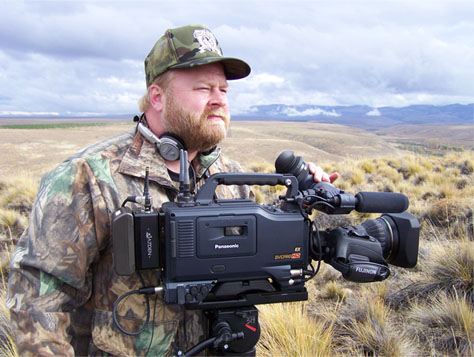
In
Argentina, Buck McNeely stands by his Panasonic AG-HDX900,
powered by an
Anton/Bauer Dionic battery.
“The keys to the show’s
success are its environmental and conservation aspects, and its
travel and tourism elements,” McNeely points out. “There’s a lot
of fascinating content even for the people who aren’t inclined
towards hunting shows.”
McNeely has been hunting
since he was a boy. As a mass communications major at
Southeast
Missouri State University,
he incorporated his love of the wilderness and an interest in
television production into The Outdoorsman. The first
four episodes aired on cable access and featured stories on
fishing and hunting in the local area. Viewer response was
enthusiastic. A syndication deal was cut and soon The
Outdoorsman went international, shooting in such far-flung
locales as Siberia, Brazil, Costa Rica and Africa. In the
process, McNeely would discover that shooting in the Arctic
tundra and the sweltering jungles of South America makes
Missouri’s extreme seasons seem temperate.
“Without question there
was a learning curve, and I had to learn a little bit on every
shoot and adapt and develop skills that are still in play
today,” says McNeely.
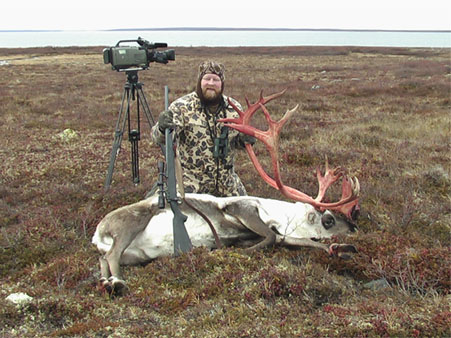
Shooting in Arctic-level cold is a common situation for McNeely.
The earliest lessons
McNeely and his team learned were to have the camera ready at
all times and to focus on getting footage of the game.
“Adventure photography is the toughest production scenario in
the industry,” he adds. “Unlike a studio shoot where you fire up
the lights and let your talent do their thing, the animals never
read my script. We’re totally at the mercy of Mother Nature, and
if she decides to create havoc with the weather or the animals,
you can come home with nothing but a bunch of scenic shots
because that’s all that was presented to you.”
Location photography for
The Outdoorsman is structured in a way that allows
McNeely and his cameramen to work around almost any situation
presented to them. Whether they’re hunting brown bears or
fishing for marlin, each episode is written in an
“ass-backwards” fashion, as McNeely puts it: Get the animals or
the fishing sequence and then write the story and produce the
show based on the footage, “whereas most of the time you write
the script then shoot the show.” In the aftermath of the kill
shot or the catch, after the animal’s been dressed and removed,
McNeely and cameraman John Helgren will stage the approach and
the setup. “That’s the Hollywood part,” McNeely admits.
In the event of extreme
weather, different locations require different contingencies.
Cold or humid environments call for rain slicks and hair dryers
to keep the camera running. And generators are relied on to keep
the batteries charged.
Still, there’s been more
than a few technical hiccups over the years — from breakdowns to
loose screws to water damage — even as McNeely consistently
adapts to newer, more efficient technologies. From 1985 to 1990
The Outdoorsman was shot to 3/4" tape using a camera
tethered to a field VTR. The cameramen needed to be strong
enough to hump the gear through a swamp or two feet of snow. In
1990, McNeely upgraded to a far lighter Beta SP cam and shot
with that format until 2000, when he began using an
Ikegami
digital Editcam
unit. The Outdoorsman went HD in 2007, when the DVCPRO HD
Panasonic
AJ-HDX900 and
the
AG-HVX200
entered the mix.
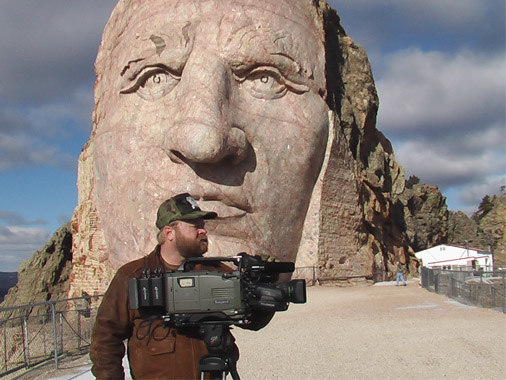
McNeely sets a shot with his Ikegami Editcam at the
Crazy Horse Memorial
in South Dakota.
The tape-based HDX900
sports a
Fujinon
22x7.8mm
telephoto lens with 2x extender and serves as McNeely’s primary
camera. The HVX200 is used only for close-up and medium-range
photography, but it still works enough to warrant packing two
64GB, two 16GB and two 8GB P2 cards when in the field. “If I
find myself in an extreme cold scenario, I’ll shoot with the P2
cards over the tape,” he reports.
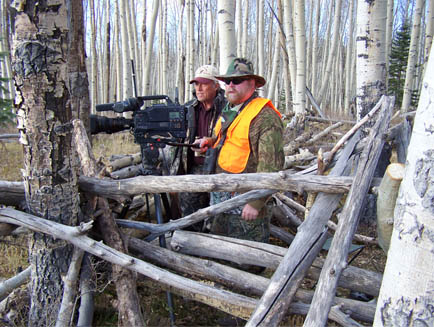
Spotting shots with outfitter Dave Holbrook and the HDX900.
When shooting with P2
media, McNeely swears by his
Nexto
NVS2500, a
compact mobile storage device for video. “It’s such a lifesaver
in the field because you’re able to dump your files so you can
reformat cards and keep shooting,” says McNeely, who operates
with two 500GB Nexto units. “They really came in handy on our
last Costa Rica trip, where we had the ability to clear off the
cards and reuse them again and again over the course of the
day.”
Another favorite field
gadget is a
Marshall
6.5" LCD monitor
with SunBrite Technology: “I use my Marshall not only for
shooting real time but for playback. It’s so bright, you can
focus by it and check your shot in direct sun without a hood.”
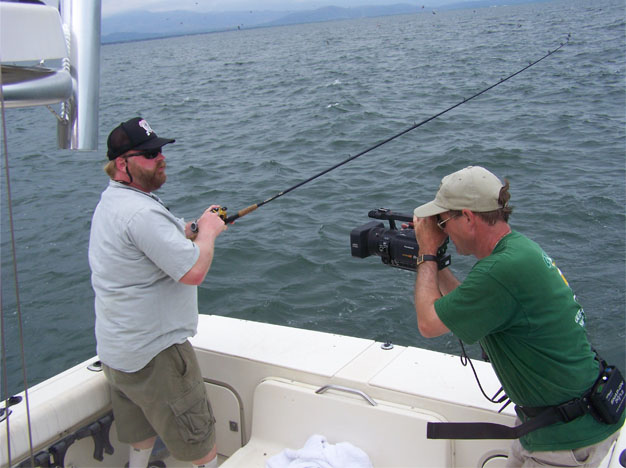
Videographer John Holgren angles in with an HVX200, McNeely's
go-to camera while shooting in close quarters.
Sunlight is something
McNeely’s learned to be aware of — 98 percent of what he shoots
outdoors is in available light. “Dawn, dusk and low-light
conditions are certainly challenging. Oftentimes game is moving
at that point, so you have to be aware of camera angles, sun
position and shadows.” The other two percent of the time he’s
using either a
Litepanels
Micro or Micro
Pro for extra illumination.
There’s a careful
approach to what McNeely does every week, not only in producing
an entertaining show but also in the work he does as a game
hunter. All of the animals taken down on The Outdoorsman
are donated to local tribes or otherwise utilized in their
entirety. Nothing is wasted. “The hunter is still an important
aspect of game management programs worldwide,” he notes.
“Sometimes people need to be reminded of the importance of man’s
role as a predator in nature.”
That’s something anyone
who tunes in to The Outdoorsman is unlikely to forget.
For more
detail on The Outdoorsman, go to McNeely’s site at
www.outdoorsmanint.com.
|
